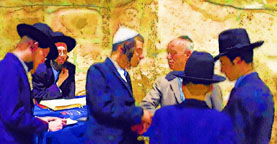Nicodemus
Samaritan Woman
Lame man at the pool

Nicodemus
Samaritan Woman
Lame man at the pool

Another way of saying this is that the first part of John deals with those who are potential disciples, while the second part with those who are actual disciples. If John 1:11-12 lists the table of contents for this book on discipleship, then John 12--the halfway point--also records a summary of how effective the "public" Jesus was. "Although he had performed so many signs in their presence, they did not believe him" (12:37). In general, the signs and the speeches did not win the masses, the crowds. John 12 also stresses that Jesus did not expect that his work would be popular among the people (12:38-43). Rather the focus of his ministry was on individuals who in some way responded. "The one who believes in me believes not in me but in the one who sent me. The one who sees me sees him who sent me" (12:44-45, emphasis mine). In this respect, progress was made, and the first 12 chapters show points of light. The message of Jesus fell on deaf corporate ears; but here and there were individuals who did respond and believe Jesus.
The purpose of this essay is to look at a few of those individuals profiled in John 1 12. We might call them "potential disciples." Some of these figures enter and exit the scene quickly and almost anonymously. But there are others whom the Gospel describes in surprising detail. John's concern for their personality and development comes close to the modern reader's interest in psychological and internal characterization. His clear literary intention is for readers to find a little of themselves in the individuals profiled.
The first persons Jesus meets (after John the Baptist) and summons are those who turn out to be numbered among the closest disciples, perhaps to be thought of as the Twelve.(3) All of those named in John 1 (Simon, Philip, Andrew, and Nathaniel) appear in later Gospel passages, and the two unnamed persons may be the "sons of Zebedee" also mentioned later. The point is that they have chosen Jesus from the outset and will remain until the end. They stand for the type of disciple who has irrevocably cast his lot with the Master. They are the ones present for the last words of Jesus delivered in chaps. 13 21. I will not focus on these few, because John does not, for the most part. Except for Peter, Thomas, and the "Beloved Disciple," they are as faceless as the chorus around the hero of a Greek tragedy.
This assumption of resolute discipleship does not hold true for the next batch of individuals the Gospel next presents. Among these people are John's most well known and loved characters: Nicodemus, the Samaritan woman at the well, the paralytic at the spring, the man born blind. These persons appeal to us because they have color and depth, questions and problems. They are like the rest of us who do not jump into discipleship without a lot of wavering and caution. Jesus encounters these people individually and addresses each one personally. They respond honestly and realistically. Not all of them end up "on board." These four constitute a short list of characters that could have also included the mother of Jesus, Lazarus' sister Mary, the official with the sick boy, and others. Nicodemus, the Samaritan woman, the paralytic, and the blind man suffice to give a survey of the varied responses to the call of discipleship.
1 John 21 is often thought to be the conclusion to the Gospel with its own literary history. Even so, the focus is on the "private" Jesus who instructs those disciples who have decided to follow him closely.
2 All translations are my own.
3 The "Twelve" are only mentioned twice
and never enumerated by name. Apparently the Gospel assumes the readers'
familiarity with them, and they do not play a role in the Gospel's purposes
in the first 12 chapters.